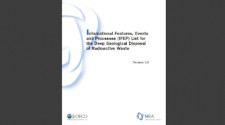
The Nuclear Energy Agency (NEA) has recently published Version 3 of its International Feature, Event and Process (IFEP) List. It is available in two formats: as a PDF report; and via an online database which is designed to store the IFEP List and other project-specific FEP lists in an easily navigable and searchable format. Quintessa has played a leading role in both the production of the report and the development and implementation of the online database.
The NEA’s Integration Group for the Safety Case (IGSC), and its predecessor, the Performance Assessment Advisory Group (PAAG), have been involved with the compilation and use of FEP lists and databases of relevance to safety of deep geological repositories (DGRs) since the early 1990s. The latest IFEP List produced by IGSC is a comprehensive and structured list of generic Features, Events and Processes (FEPs) relevant to assessments of post-closure safety. It is intended to support national programmes in the production of their safety cases through the provision of a comprehensive and internationally accepted list of factors that may need to be considered when assessing the safety of DGRs. It is relevant to both safety assessors and individual topic experts, to all DGR designs of geological disposal facilities, and to all categories of radioactive waste intended for disposal in DGRs.
The online NEA FEP database has been designed to provide a home for all releases of the IFEP List in future and can also host project-specific FEP (PFEP) Lists. Currently two such PFEP Lists have been published: the NAGRA Opalinus Clay (OPA) FEP List, 2002; and the ONDRAF/NIRAS FEP List. The application provides version control and review and approval processes, and can support defining relationships between FEPs including between PFEP and IFEP Lists. The application has an administrative interface through which the NEA and member organisations can manage their FEP lists, and a public facing interface though which published versions of the FEP Lists and links between them can be viewed in a read-only format.
Quintessa has supported the NEA by:
- reviewing relevant recently produced project-specific FEP lists;
- proposing revisions to the previous IFEP List in light of the review;
- populating the updated IFEP List with relevant information such as a description of each IFEP and a commentary on its relevance to performance and safety;
- developing a web-based database for the management of all FEP lists; and
- implementing the updated IFEP List in the web-based database.
